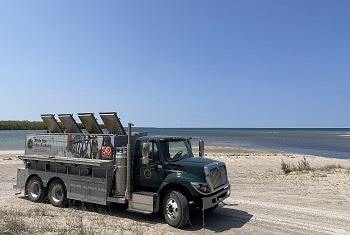More than 33 million fish stocked in MI this spring and summer

The Department of Natural Resources yesterday announced the final totals from its spring and summer fish-stocking efforts. The DNR’s Fisheries Division stocked a total of 33,308,068 fish that weighed more than 343 tons and consisted of nine different species and one hybrid.To complete this task, it took more than 400 stocking trips to more than 750 stocking sites, with travel totaling more than 105,000 miles over the course of 2,624 hours using 17 specialized stocking trucks.
“We experienced outstanding spring and summer stocking seasons that will bring significant benefits and fishing opportunities to Michigan anglers,” said DNR Fish Production Manager Ed Eisch. “With the hard work and dedication of our staff, fish were reared and delivered to stocking sites in excellent condition. The numbers produced and stocked were right on target for almost all areas.”
The number and type of fish stocked throughout the year varies by hatchery, as each location’s ability to rear fish varies because of and the source and temperature of the rearing water. In Michigan there are six state and two cooperative hatcheries that work together to produce the species, strain and size of fish needed by fisheries managers. These fish must then be delivered at a specific time and location for stocking to ensure their success.
Each hatchery stocked the following fish this spring:
- Marquette State Fish Hatchery (near Marquette) stocked 624,695 yearling lake trout, brook trout and splake (a hybrid of lake trout and brook trout) that in total weighed 67,476 pounds. This hatchery stocked a total of 113 inland and Great Lakes sites.
- Thompson State Fish Hatchery (near Manistique) stocked 1,045,079 fish that included yearling steelhead and spring fingerling Chinook salmon. These fish weighed 118,826 pounds in total. This hatchery stocked 68 sites (the majority located on the Great Lakes).
- Oden State Fish Hatchery (near Petoskey) stocked 626,317 yearling brown trout and rainbow trout that in total weighed 102,273 pounds. This hatchery stocked 182 inland and Great Lakes sites.
- Harrietta State Fish Hatchery (in Harrietta) stocked 1,122,827 yearling brown trout and rainbow trout that in total weighed 98,089 pounds. This hatchery stocked 275 sites (the majority located inland).
- Platte River State Fish Hatchery (near Honor) stocked 2,550,355 fish that included yearling Atlantic salmon and coho salmon and spring fingerling Chinook salmon that in total weighed 168,246 pounds. This hatchery stocked 19 sites (the majority located on the Great Lakes).
- Wolf Lake State Fish Hatchery (near Kalamazoo) stocked 986,089 fish that included yearling steelhead and spring fingerling Chinook salmon that in total weighed 124,113 pounds. This hatchery stocked 54 sites (the majority located on the Great Lakes).
- A cooperative teaching hatchery at Lake Superior State University (in Sault Saint Marie) stocked 36,790 Atlantic salmon weighing 4,847 pounds into the St. Marys River.
Included in this year’s total of fish stocked were walleye spring fingerlings and fry to the tune of 26 million. These fish are reared in ponds by the DNR and tribal partners with extensive support provided by local sportsmen’s organizations. These fish were stocked at 55 inland lakes and rivers and two Great Lakes.
“We had an exceptionally good year for walleye production. Hatch and early survival was fantastic, which resulted in many more fry than we can rear to fingerling size,” said Eisch. “Fortunately, a newly funded project included in the 2017 budget should allow us to put in additional rearing ponds at Thompson State Fish Hatchery. Expansion of Michigan’s coolwater program would get us even closer to being able to reach all of our walleye and muskellunge rearing targets.”
Fish stocking is a critical activity of the DNR. These efforts help pump between $2.4 and $4.2 billion into the state’s economy through the sportfishing industry and associated businesses. As a frame of reference, 2015 stocking efforts totaled nearly 25 million fish.
Fish are reared in Michigan’s state fish hatcheries anywhere from one month to one and a half years before they are stocked.
It should be noted that some hatcheries will provide fish for a few additional stockings to be made this fall consisting of brook trout, Atlantic salmon, lake sturgeon and muskellunge. The lake sturgeon will come from the DNR’s other cooperative hatchery in Tower that is operated with Michigan State University.
The DNR always welcomes visitors to its state fish hatcheries and interpretative centers to witness first-hand the fish-rearing process and to learn about Michigan’s remarkable waters. For more information, visit Michigan.gov/hatcheries.
The DNR maintains a public database of fish stocking records which can be reviewed at michigandnr.com/fishstock.






